iFi Pro iDSD Signature (Giant Killer!)
R78,000.00
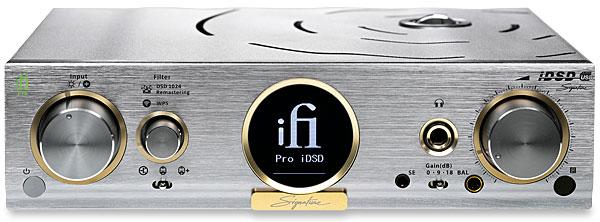
 Sporting a Signature nameplate, the flagship of iFi Audio’s sprawling digital product range has been fine-tuned with ‘audiophile’ components and offboard iPower Elite PSUNo, you’re not having a flashback, but you’d be forgiven a sense of déjà vu, given that we reviewed the original iFi Audio Pro iDSD DAC/headphone amplifier [HFN Sep ’18]. Then it sported what we thought was an ambitious £2500 price tag, and pro-audio aspirations with a range of facilities so extensive that it paid to know what you were doing when tackling its myriad options and adjustments.
Sporting a Signature nameplate, the flagship of iFi Audio’s sprawling digital product range has been fine-tuned with ‘audiophile’ components and offboard iPower Elite PSUNo, you’re not having a flashback, but you’d be forgiven a sense of déjà vu, given that we reviewed the original iFi Audio Pro iDSD DAC/headphone amplifier [HFN Sep ’18]. Then it sported what we thought was an ambitious £2500 price tag, and pro-audio aspirations with a range of facilities so extensive that it paid to know what you were doing when tackling its myriad options and adjustments.
Fast-forward three-and-a-half years and the flagship model from the Southport-based company now carries ‘Signature’ badging, glitzed-up styling, and a boost in price. The new Pro iDSD Signature is yours for £3249, or £500 more than the current £2749 of the original model.
And it’s not the only ‘Pro Signature’ model in iFi Audio’s catalogue: if you want an all-analogue headphone amp there’s also the Pro iCAN Signature in a matching format and boasting a wider range of balanced headphone outputs. It sells for £2249, or £450 more than iFi Audio’s standard Pro iCAN model.
A Feature-Fest
The new Pro iDSD Signature can still be used as a DAC, a headphone amp and even as a preamp, thanks to fixed/variable analogue outputs on both RCAs and balanced XLRs, while headphones are catered for across both balanced and unbalanced outputs. There’s also the same choice of output stages – ‘solid-state’, ‘Tube’, or ‘Tube+’, the latter employing minimal negative feedback in an effort to sound even more ‘valvey’. There’s the same vast range of adjustments available via multifunctional front panel controls, as well as its dedicated app, so it’s hardly surprising that iFi Audio backs up the product with not just a user manual, but also video connection guides.
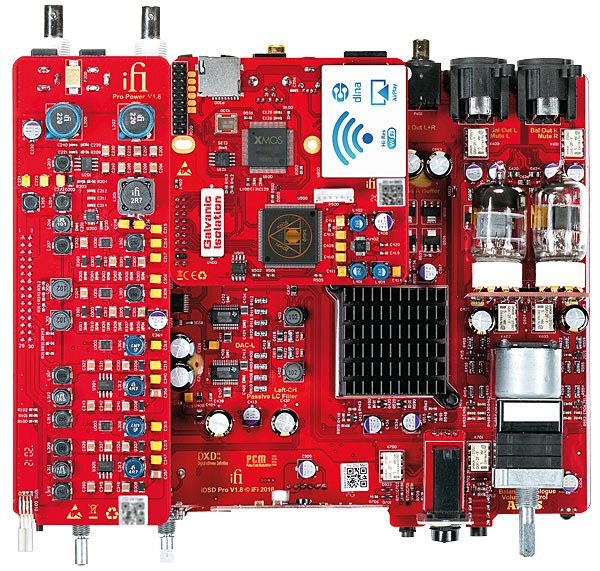
The most obvious difference, apart from all that bling, is inclusion of the company’s range-topping iPower Elite power supply, clad like the main unit in aerospace-grade aluminium, and itself selling for £299. So that’s more than half the price increase accounted for… The company claims this works in concert with the redesigned power supply board within the Pro iDSD Signature, which also uses upgraded components, to lower noise by either 300% or 300x, depending on which bit of the promotional material you read. The aim? A ‘sonically-darker background and more punchy bass’, the company says.
Also new are more precisely matched ‘new old stock’ General Electric 5670 valves in one of the unit’s two output stages, a more comprehensive alloy-skinned remote handset, and support for USB1.0 audio, should you want to use this £3249 DAC/amp with your PS4 or PS5 games system. Well, someone might…
Inputs Galore
Otherwise much is as before, including its phenomenally wide-ranging connectivity. Not only does it have a USB-B input for computer hook-up, alongside AES/EBU and a combined optical/coaxial digital input, but it can also play music from network audio sources via Ethernet or Wi-Fi. With DLNA streaming built-in, support for services including Spotify and Tidal, plus MQA decoding for those Tidal Master files, this busy little box seemingly leaves nothing to chance. Furthermore, all the electrical inputs are galvanically-isolated and the USB section is equipped with dedicated power management.
It’s also possible to play from USB drives or microSD storage cards, while the Pro iDSD Signature also accepts Apple AirPlay via its supplied Wi-Fi antenna. Finally, the unit has BNC clock inputs and outputs, should you want to sync the DAC with external digital equipment, most likely in a pro setting.
Sequestered within that casework is a stack of four interleaved DACs from Burr-Brown, permitting the unit to handle content at up to 768kHz PCM and DSD1024. There’s also buffering upstream of the DACs to suppress jitter and custom software running on an FPGA to ‘remaster’ music up to DSD1024 if required.
IFi Audio’s menu of digital filters is now the stuff of legend – à la carte options including ‘Bit-Perfect’, ‘Bit-Perfect+’, ‘Gibbs Transient Optimised’ (said to ‘add gravitas and a new dimension’), ‘Apodising’ and ‘Transient Aligned’. Regular readers will know what’s coming next – by all means play with these to your heart’s content, but you might well spend a lot of time scrutinising them when you could be enjoying music instead.
REVIEW: iFi Pro iDSD Signature DAC, Streamer.
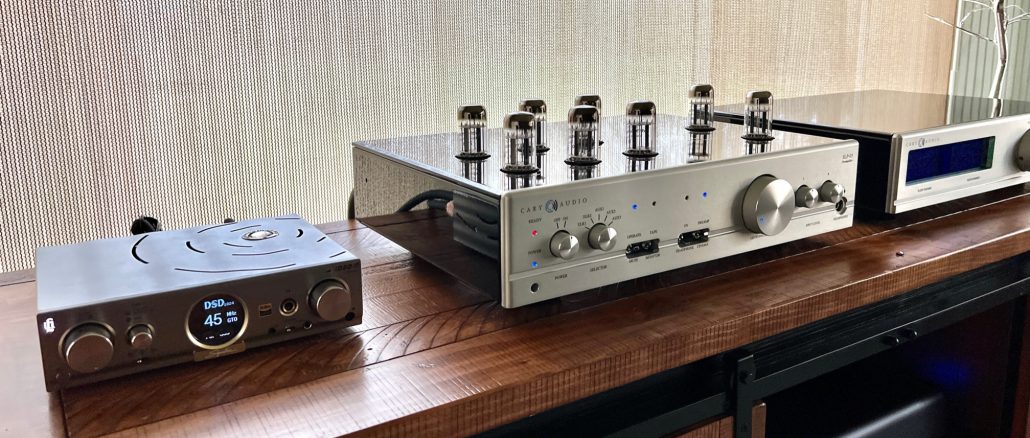
REVIEW: iFi Pro iDSD Signature. Dac, Streamer, HeadAmp.
By Steve Huff
Buy the iFi on Amazon via Prime HERE.
I was pretty excited when iFi contacted me to review their pro level top end DAC. It’s called the Pro iDSD Signature and it is iFi’s top tier flagship DAC with a Streamer, Pre-Amp and Head Amp included. It’s even available at Amazon, via PRIME.
I have had the pleasure of listening to many DAC’s over the last few months. I have heard some very amazing pieces that range from the $500 price point all the way to the eye watering $15,000 price point. I did a bunch of DAC auditions as I was trying to find the best fit for my reference system. At the end of the day I chose the Weiss DAC 501 as my reference DAC. It’s not new, but it offered the best sound I have heard from digital, regardless of cost or brand name.
While it is easy to hear the changes as we climb the price ladder in HiFi, there are some lower cost options that really do punch above their price point. One that comes to mind is from iFi and I reviewed it HERE.
I can say with confidence that the Pro Signature iDSD DAC is much more refined and high end sounding than the $700 Neo version linked to above. No question there. In fact, and this is a bit of a spoiler….I will tell you now that the iFi Pro iDSD Signature is my pick for best DAC at the $3500 and under price point.
I will explain in the review below why I feel this way about the amazing piece of HiFi. It’s like a Swiss army knife for your audio system and one that allows you to “lock in” the right sound for your system.
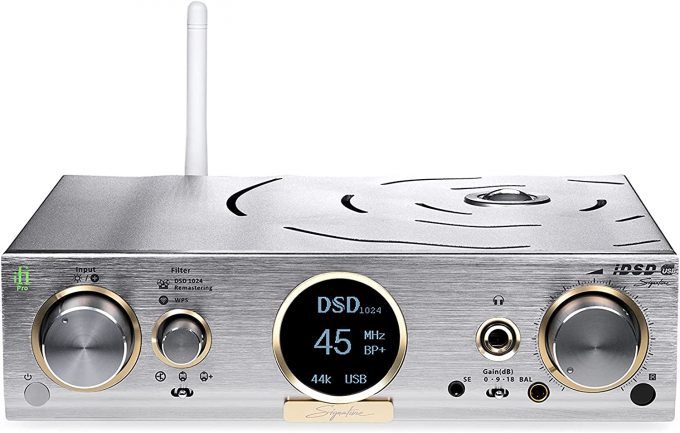
ALL IN ONE
The iDSD Signature is truly a one stop shop for those who want small size, less boxes and stunning sound and quality. This is not a cheap purchase my friends. The iDSD Pro Signature comes in at $3499 but remember what iFi is providing here. A one stop shop for your digital front end that includes all one needs for high quality streaming and decoding of your digital music.
This is also a Headphone amp but I will only be reviewing it as a DAC as that is how I used it.
I have been listening to the iFi for a a couple of months now, and comparing it to some pretty mighty DAC’s. The Weiss DAC501, the Chord Dave, the Nagra Classic DAC and the Denafrips Terminator II are DAC’s in that upper echelon of audio. They create some of the best digital I have ever heard.
The lower cost iFi sounds a bit different from all of these, but does indeed offer up a refined high end sound that gets somewhat close to those dacs listed above. In some cases, scary close.
At $3500, this DAC can and does get close to the big boys that cost more.
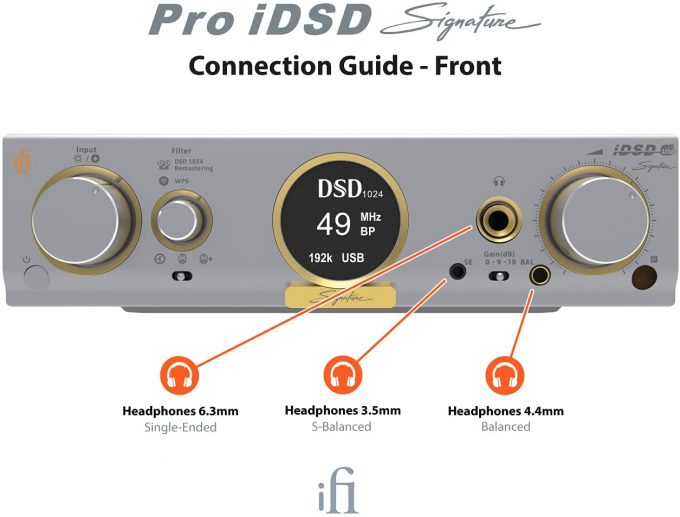
Hook Ups. Wireless or Wired.
When the iDSD Pro Signature is taken out of the box you will be greeted with a small silver box that has many inputs and options for setup. You can go wired, by plugging in your ethernet cable directly to the unit. This will allow you to stream without lag, drop outs or issues. If you do not have an ethernet cable near your system, you can go wireless. This little guy can hook up to your WiFi as well, so no problem setting it up as it offers both options.
I tested the iDSD Pro Signature with a wired connection, wireless, using it as a streamer and DAC and just a DAC with my Lumin U1 mini streaming the tunes to the DAC.
No matter how I set it up I had no issues at all. No drop outs, no weird audio glitches. This was good ; )
You can see the two NOS GE tubes in place…

To Tube or Not to Tube?
The beauty of this iDSD Signature is that it has several ways to tweak the sound. It’s almost overwhelming out of the box and will take some time to dial in for your sound preferences.
You can run it without the two NOS GE tubes or flick a switch to enable the “tube glow” and activate the tube goodness. I call it that as when you enable the tubes the sound does bring more warmth and glow along with a slightly fuller sound. It’s pretty cool to be able to change the sound of the DAC on the fly.
This allows you to tune it a little bit to your system.
Need some tube magic? Flick a switch. Want the more expansive solid state presentation? Leave the tubes off. Simple. I love the fact that every setting is done with a switch or button push. I love tactile pieces of gear over those where you must change settings via a menu. The Pro Signature allows us to make these changes, all on the fly, via physical switches and dials.
Any input you may need…
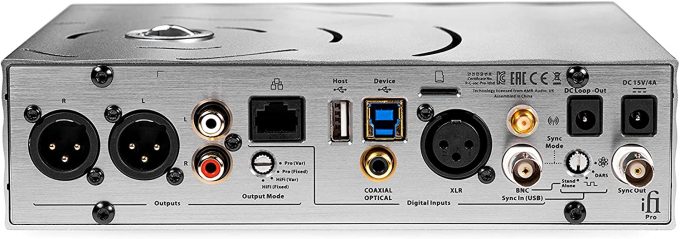
FILTERS
There are also filters that you can enable with a flick of the dial. While there are many options to choose from I usually preferred the Bit Perfect option. It just sounded best to me but there were times when I did enjoy and prefer the other filters that did upsample to DSD. When we upsample to DSD the sound does get smoother and more refined.
The Filter Options
The iFi Pro DSD Signature offers up a plethora of filter and upsample options.

The filters do change the sound and are well worth experimenting with. I lived with one setting for two days at a time. This allowed me to hear the differences easily. When we switch back and forth within seconds, it can be tough to figure out what the best setting is. I enjoyed living with each setting for two day’s at a time. This is how I was able to dial it in perfectly for my tastes.
The Looks, Build and Sound
I will admit, I am not a big fan of the style of the iFi. It’s gold trim over the silver is a bit much for me, but it’s still a handsome unit. It’s also a personal preference and your tastes may differ. I remember I once loved a Shanling CD player that had silver and gold highlights. It was blingy and different which is why I enjoyed it at the time. Today not so much. Even so, the iFi is not ugly by any stretch of the imagination. It’s just different from what I have been used to placing in my system.
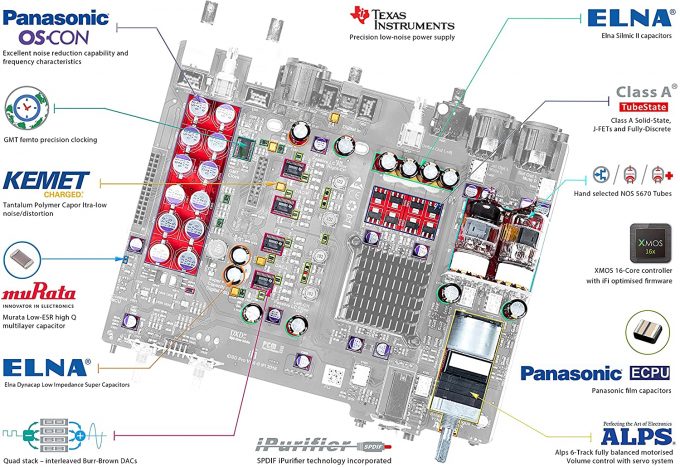
The iFi DAC comes in a small squat box that has decent weight to it. Its a dark silver, almost like a steel grey. It has a small circular display that lets us see what is happening.
There is the switch to enable one tube, or two. There is a switch for headphone amp gain. There is a dial for selecting the filter modes, and upsampling modes. Turn to choose filter, push in to select upsampling modes. There is also a big volume dial. For listening to speakers, within a HiFi system there is also a setting in the back that allows you to set the output of the DAC. I set I to the HiFi mode, and I let my preamp control the system volume.
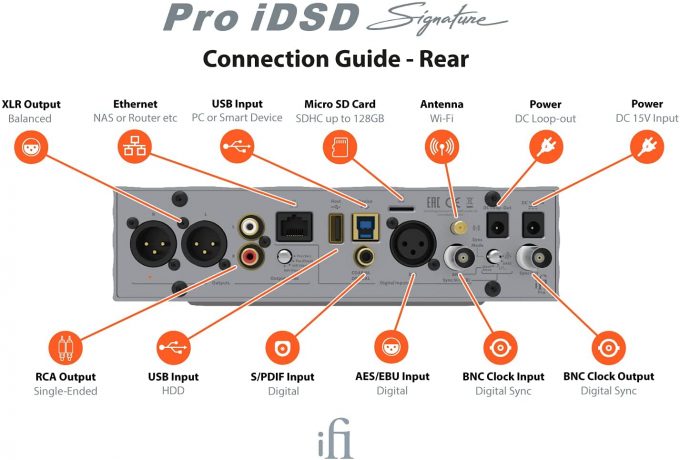
The iFi has various inputs. You can plug in your ethernet cable and use it as a streamer and DAC. This allows us to stream right from our phone via Spotify, Tidal, Qobuz, etc. I have tested this with my Lumin U1 Mini streamer via USB and I may slightly prefer using the iFi as a streamer. The sound is slightly better to my ears. I will say though, as a streamer this is not ROON READY. It is with my Lumin being used as the streamer.
There are single ended RCA outputs and XLR balanced outputs.
Being a streamer, a DAC, a headphone amp and having the option of tubes and various upsampling or bit perfect modes makes this a true all in one piece for a digital front end. It’s rather incredible what we get for the money here. No, it doesn’t have a big fancy display but it’s also not $6,000.
I feel iFi created a piece here that allows those of us without huge system budgets to experience a huge heaping helping portion of that high end sound we get from those DAC’s in the $8-10k range.
Everything that comes in the box
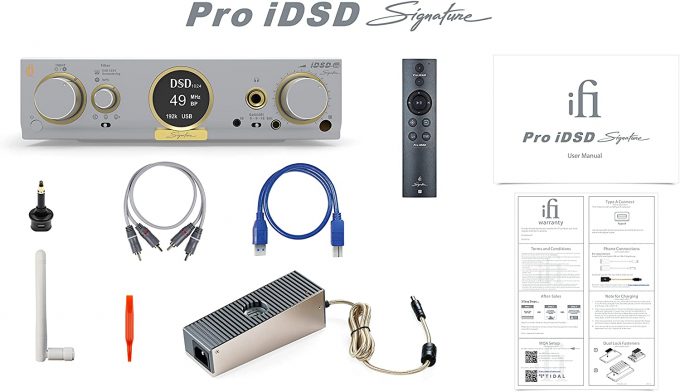
SOUND
When I first plugged in the iFi I had just come off of a listening session using the Chord DAVE. The DAVE is a world class DAC, one of the best in the world even today in 2022. I found the iFi to sound overly smooth in comparison at first power up. It took me a couple of weeks of experimenting with the settings which helped me mate it to my systems audio signature. It was then that the entire sound signature changed (for the better, big time).
This is not a plug in and forget it DAC. It will require some time for you to get it dialed in but once you do, it’s a very special piece.
Once I did this, and tweaked it to my system I absolutely fell in love with this amazing piece of technology. I started to enjoy it more than some of those pricer DAC’s, which was incredible since the price difference was so drastic between them. While the Weiss 501 is my reference and the iDSD does not beat it for these ears, the little DSD Pro Signature delivered some killer sounds from my reference system that would please 99.8% of music lovers.
In fact I feel going higher up the chain than this DAC here is strictly for those who are the picky “never satisfied” audiophiles (like me, I am HARD to please when it comes to cameras and audio gear). I can say with confidence that if you buy this DAC you will not be missing out on too much when compared to the uber $10k and up DAC’s.
You may lose a little depth, refinement, dynamics and 3 Dimensionality when compared to the best of the best but as we know diminishing returns is very real. Spending $10k on a DAC doesn’t get you $6500 more performance than what you would get from the iFi.
While the nearly $10k Weiss 501 delivered “in the studio” performance that has yet to be bettered by any DAC I have heard, the little iDSD was closer to the $15k Nagra Classic in the way it presented the soundstage width and 3 dimensionality. I mean…very close.
For vocals, Jazz, easy listening kind of stuff I loved the iDSD set to the “Gibbs Transient Optimized Digital Filter” and upsampled to DSD resolutions. What a sound this brought to my room. It was very alive, very 3D and very WIDE OPEN. The sound expanded to the walls and I could find no faults AT ALL with the sound. I was just enjoying the tunes.
With a tad less meat on the bones than the Weiss 501, I was enjoying amazing transparency from my Fleetwood Deville speakers. These speakers respond very well to gear changes, and the iFi was bringing beautiful music to them that was airy, wide and almost as realistic as the best I have heard.
Interestingly enough, the iDSD offers up a wider soundstage than my reference Weiss. It has some of that holographic magic as well that brings artists to the room with you.
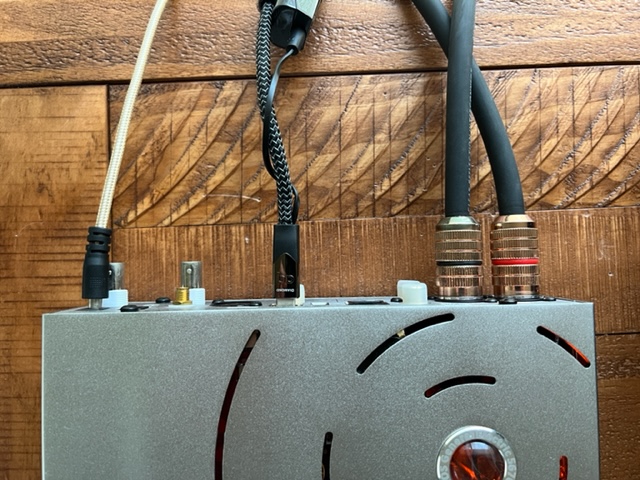
When I switched to some hard rock and metal I enjoyed the sound most with one of the tubes engaged along with bit perfect mode engaged (no upsampling). I flicked that tube engage switch and waited for the tube to heat up (about 20 seconds). With the tube activated the sound gets a little more beefy which is perfect for rock and metal. It does add an ever so slight tube flavor to the sound, which is cool. This is a true Swiss Army Knife for your system because you can tailor the sound to your setup.
With the tube engaged the vocals had a larger presence as well. More forward and big rather than slimmed down and pushed back.
I could not believe the sound I was getting for rock and metal as in this tube mode it was big, bold, beefy and still retained a magic about it. I kept saying to myself “WOW, this is amazing for this kind of money”. Yes I feel $3500 is a lot of cash and this is not a “cheap” DAC to acquire. With that said most DAC’s under this one that I have heard do not match the versatility of this one. Well, none do. Meaning, most DAC’s at this price or under do not allow you to customize the sound to your system.
The iFi next to the AMAZING END GAME worthy Cary SLP05 Pre Amp (with the ultimate upgrade).
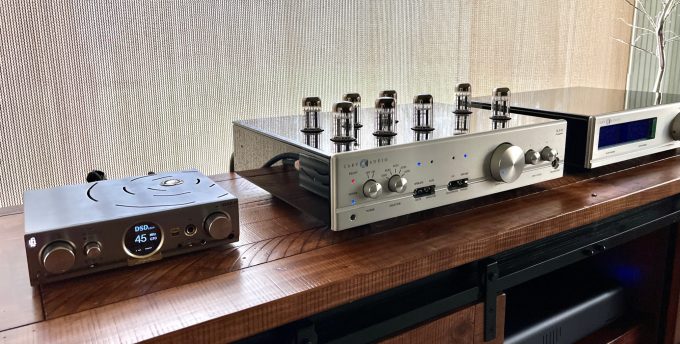
For example, the Denafrips Pontus II is a crazy good DAC and at $1800 direct from Singapore is an insanely good buy. If you just want a set it and forget it DAC for under $3500, the Pontus II is a “MUST LOOK INTO” kind of DAC. Where the iFi beats the Pontus is in the way it allows us to choose filters on the fly, activate one or two tubes on the fly, or even use it as a streamer. It allows us to slightly change the sound and this can make a huge difference for some systems. It’s more alive and a little less relaxed than the Pontus as well.
Building an audio system is about synergy. Sometimes one piece can make or break your system. I enjoy the iFi because it allowed me to go from thinking it was too smooth to delivering sounds I never knew could come from this little box. It allowed me to set the DAC up so it created a nice synergy within my system.
Keep in mind these differences are not huge, but subtle. For example, without the tube engaged I get an airier sound with a bigger soundstage width. When I click the tubes on, the soundstage shrinks a bit but the midrange vocals get bigger, and I get a feeling of more “oomph” in the sound. It’s pretty nice to have and is almost like having two DAC’s in one, both solid state and tube.
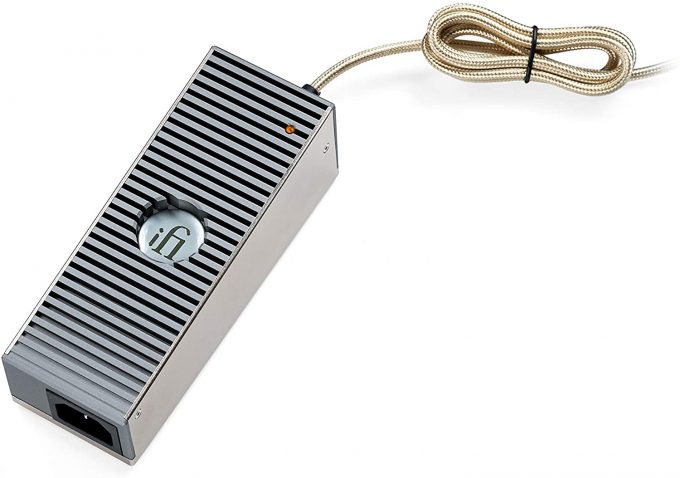
The iDSD also comes with a unique power conditioner of sorts. In the box is their iFi Power Elite Low Noise Power Supply Adapter. This is normally $300 on Amazon all by itself but it was inside the box, included.

This helps keep noise to a minimum and is like having a power conditioner for the DAC. This is unheard of and I have never seen a DAC come with anything like this. I can say that this DAC was 100% silent in my reference system.
I am a big fan of the $1800 Chord Qutest DAC but the iDSD beats it for my preferences due to that versatility it brings. It’s a tad warmer than the Chord, not as textured in the details but also offers up a sound that is a little more musical and one that flows perfectly. This is a high end DAC my friends, and iFi did an amazing job creating this all in one when it comes to BANG FOR THE BUCK.
I used to think “Bang for the Buck” really meant a cheaper product was able to get close to a much more expensive one. In the case of the iFi, I say this meaning it is not a cheap product in any way, but rather is a true high end piece that delivers the performance more in line with those DAC’s that cost a fortune. It is “cheap” in price for what it is.
I am not saying it bests those uber fi pieces, but it does get close. Some may even prefer the iFi to some of those $10k and up DAC’s as it is all about personal preference and no matter the cost of a HiFi piece, there is no “better” just “different”.
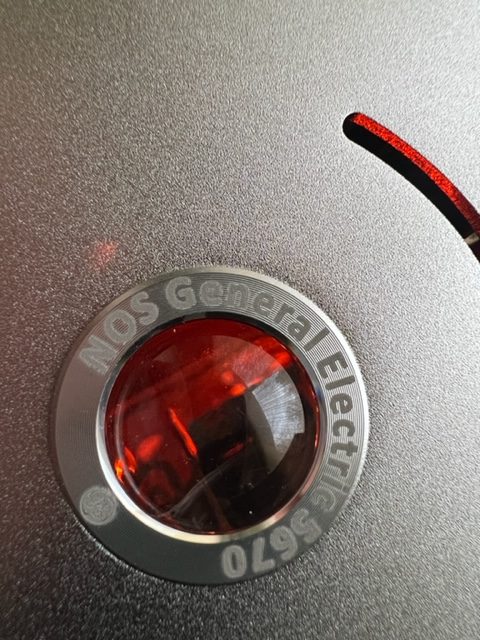
Who is this for?
If you have a system that you set up for critical listening, such as a “sweet spot” listening space where you can experience that holographic magic and emotion from music then a DAC is a very important piece in your system. It’s one of the most important in my opinion. If you have a system setup like this, or want to set one up then never skimp on the DAC.
I have seen many spend a fortune on speakers and amp but go cheap on the DAC, Streamer and Cables. This is like buying a Ferrari and putting cement blocks on it for tires. An audio system designed for an emotional listening experience needs quality throughout from start to finish. It depends on your goals. If you have a “party system” that you blast for gatherings then any DAC will do, even a $20 DAC ; )
If you have had reservations about investing in a quality DAC, the iFi is one you can jump into without going crazy on a $10k DAC. In my case, it brought 85%-90% of what the $15k Nagra Classic DAC did once I had it set up for my system. This is a DAC I could live with for the long term and while my Weiss DAC501 brings me more enjoyment and WOW factor, once the iFi was in my system for weeks, my memory forgot about the Weiss, and I was just enjoying the beautiful music from the iDSD.
This DAC kicks my friends. It’s all one needs for much less than those big ticket big name pieces of audio gear. I prefer it to any DAC I have heard under it’s price point. Period. It also offers so much more than any other DAC I have had through here in the way of customizations.
Description











